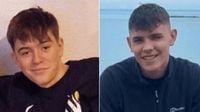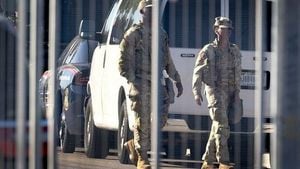On a rain-slicked stretch of the A91 near Bannockburn Interchange, a tragedy unfolded that would ripple through the lives of families and a community, and ultimately raise unsettling questions about road safety and the limits of blame. Charles Gray, then just 17 and newly licensed, was behind the wheel of his 2006 Vauxhall Corsa on March 17, 2024, when a split-second loss of control on a notorious “greasy corner” led to a devastating collision. The aftermath would see him fighting for his life, mourning the loss of his two best friends, and standing trial for their deaths.
Gray, an apprentice electrician from Bannockburn, had passed his driving test only the month before the crash—on St Patrick’s Day, no less. That afternoon, he, his girlfriend Lauryn Moir, and friends Jayden McConnell, 17, and Kyle Marshall, 19, had just left Stirling Services. As Gray’s Corsa joined the A91, the car suddenly spun out of control on the wet surface, crossing the center line into the path of a heavy tipper lorry. The lorry struck the car side-on, causing what investigators later described as “a significant intrusion” into the rear of the vehicle—where Jayden and Kyle were sitting. Both young men died at the scene from multiple injuries, according to BBC News and other outlets.
Lauryn Moir, in the front passenger seat, escaped serious injury. But Gray himself suffered catastrophic harm: a ruptured spleen, spinal damage, and a traumatic frontal lobe brain injury. He was found not breathing by an ambulance crew that happened upon the scene by chance, already en route to hospital with another patient. Their quick intervention saved his life. Gray was airlifted to hospital, where he spent nearly two months in recovery, much of it in an induced coma.
Gray’s own recollection of the crash is a blank. “I remember nothing of the accident or the journey leading up to it,” he told his counsel, Tony Graham KC, during the trial, as reported by STV News and the Scottish Daily Express. He described waking four weeks later, disoriented in hospital, only to learn from his mother two days later that Jayden and Kyle had died in the collision. “I was broken that they’d passed away—broken. I still feel broken to this day. Nothing has changed. I feel, now, what I’ve gone through is nothing compared to what the families of the boys went through and are still going through to this day,” he said, his voice often catching with emotion.
The case that followed was as much about the limits of personal responsibility as it was about the unpredictable hazards of the road. Prosecutors charged Gray with causing the deaths of his friends by careless driving. But the evidence presented during the five-day trial at Stirling Sheriff Court painted a far more complex picture. According to The Scottish Sun and other sources, an analyst who examined data from the Corsa’s insurance company “black box” found that Gray had been “the perfect driver” until the fateful moment of the crash. Two eyewitnesses described his driving as “normal” or “not reckless,” and said he was traveling at about the same speed as other traffic before losing control.
The defense also highlighted significant gaps in the police investigation. A police expert who examined the car after the crash admitted it was “unknown” whether a mechanical fault might have contributed. Crucially, police vehicle examiners had not performed about 20 checks on the wreckage that could have provided more insight. Nor were they equipped with a code reader to analyze the car’s on-board diagnostics system, which might have revealed a braking defect. The police also failed to test the slipperiness, or coefficient of friction, of the road surface at the crash site—an omission that drew pointed criticism in court. The A91 exit where the accident occurred was known locally as a “greasy corner,” and another driver testified to having slid there just hours earlier.
Police accident investigator PC Yvonne Smith told the court she found no physical evidence—no skid marks or gouges—to pinpoint exactly where Gray lost control. When asked by defense counsel if she had any knowledge from the physical evidence about the point the car was out of driver control, or the coefficient of friction at that point, she replied, “That’s correct,” indicating a lack of definitive answers.
Jurors were also shown dashcam footage repeatedly during the trial. The footage captured the Corsa rotating clockwise and veering onto the wrong side of the road, directly into the path of the oncoming lorry. Gray himself said, “Ever since I saw that footage being played I can’t stop imagining it when I’m sleeping.”
After hearing all the evidence, the jury took less than two and a half hours to reach a verdict. On November 11, 2025, Charles Gray was found not guilty of causing death by careless driving. Sheriff Euan Gosney told him simply, “You are free to go.” The courtroom was silent as the verdict was read; both Gray’s family and the families of the deceased sat quietly, absorbing the outcome.
The verdict did not erase the loss or the lingering pain. Gray, now 19, continues to deal with the consequences of his injuries, which affect his daily life and ability to concentrate or control his emotions. But as he told the court, his suffering pales in comparison to what the families of Jayden and Kyle endure.
The case has left many in Stirling and beyond reflecting on the dangers posed by known hazardous stretches of road, and the importance of thorough accident investigations. The “greasy corner” on the A91, infamous among local drivers, remains a stark reminder that sometimes, tragedy is the result of a confluence of bad luck, weather, and circumstance—rather than reckless intent.
For Charles Gray, the legal ordeal is over, but the memories and the sense of loss are not so easily left behind. The story of that day, and the lives forever altered, continues to echo along the rain-slicked roads of central Scotland.





